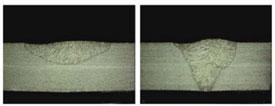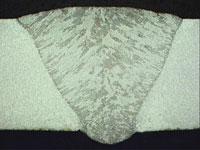President
- FMA
- The Fabricator
- FABTECH
- Canadian Metalworking
Categories
- Additive Manufacturing
- Aluminum Welding
- Arc Welding
- Assembly and Joining
- Automation and Robotics
- Bending and Forming
- Consumables
- Cutting and Weld Prep
- Electric Vehicles
- En Español
- Finishing
- Hydroforming
- Laser Cutting
- Laser Welding
- Machining
- Manufacturing Software
- Materials Handling
- Metals/Materials
- Oxyfuel Cutting
- Plasma Cutting
- Power Tools
- Punching and Other Holemaking
- Roll Forming
- Safety
- Sawing
- Shearing
- Shop Management
- Testing and Measuring
- Tube and Pipe Fabrication
- Tube and Pipe Production
- Waterjet Cutting
Industry Directory
Webcasts
Podcasts
FAB 40
Advertise
Subscribe
Account Login
Search
Improving GTAW for producers, fabricators
Mixed metal oxides aid in making deeper, faster welds
- By Dr. Yehuda Baskin and Dr. Ian Harris
- July 19, 2013
- Article
- Arc Welding

Figure 1: Two welds, identical except for the use of the DeepTIG process (right), show markedly different weld profiles.
Gas tungsten arc welding (GTAW), a joining process developed decades ago, has found an important niche among tube and pipe producers and fabricators. Initially known as heli-arc welding because it relied on helium to shield the arc from oxygen contamination, the basic process hasn’t changed much since its inception: It uses an arc between a nonconsumable tungsten electrode and the workpiece to produce a weld pool, and it needs a shielding gas to protect the molten weld pool from contamination by oxygen in the ambient air.
While the process is essentially unchanged, the equipment and consumables have been modernized over the decades. AC welding units, water-cooled torches, alternative tungsten electrode formulations, and the use of argon to shield the arc, either alone or in combination with helium, have helped to improve the process. Also known as tungsten inert gas (TIG) welding, it has become an indispensable tool for many manufacturers in industries as diverse as aerospace, nuclear, marine, petrochemical, and semiconductors. These days most austenitic (300 series) stainless steel tubes are seam-welded using GTAW.
Another upgrade, one that uses specialized metal oxides to increase weld penetration, was awarded a U.S. patent.1 Christened EWI DeepTIG®, the EWI-developed process uses proprietary oxide formulations which, when applied to the surface of the workpieces to be joined, increase weld penetration and consequently enhance the process’s productivity. The product also is available in wire form.
Joints and Seams
The use of DeepTIG has been shown to increase weld penetration in GTAW by up to 300 percent (see Figure 1). The benefits derived from this increased penetration include reduced welding times and simplified weld joint preparation (for example, by substituting a square joint for a groove joint). It also reduces weld distortion because it provides a more symmetrical weld cross section.
The unique metal oxide formulation modifies the Marangoni flow in the weld pool, which is based on the flow of fluids with dissimilar surface tension. The modified Marangoni flow increases weld penetration, thereby improving weld quality. The product has been tested extensively by EWI and the Navy Joining Center (NJC). Repeated testing has proven that the mechanical properties, weldability, and corrosion resistance are not adversely affected in the alloys tested.
Initially the product was available only in powder form, which turns into a slurry when a quick-drying solvent is added to it. The slurry is applied manually using a fine-bristle brush. A newer variant is available in a form similar to metal-cored wire, in which oxides replace the metal, which opens up new possibilities (see Figure 2).2 Both forms are intended for fabricators; the second is also intended for use by tube and pipe producers for seam welding. 3
The process has been shown to have a positive impact on many weld characteristics and related processes.
- Weld Penetration. Increasing weld penetration improves productivity and reduces weld joint volume.
- Weld Quality. The product reduces heat-to-heat variation in weld penetration and reduces distortion. It also promotes grain refinement in some alloys.
- Welding Time. It reduces welding time as much as 50 percent in most applications.
- Manufacturing Costs. Because it reduces heat input and weld time, it reduces power and labor requirements, thereby lowering manufacturing costs.
- Joint Preparation Costs. In many applications, full penetration can be achieved with a closed square butt joint, reducing joint prep and filler material costs, heat input, distortion, and welding times.
Orbital Applications
The DeepTIG product, originally developed for the U.S. Navy’s shipboard piping systems, used mechanized and orbital welding systems to weld tube and pipe butt joints.4 The welding equipment used for GTAW with DeepTIG is the same as that used for conventional GTAW (see Figure 3).
Maintaining a short arc length (0.050 in.) is critical to ensure maximum penetration during welding. Arc length is a critical variable in the repeatability of welds made with DeepTIG products, so the use of automatic voltage control (AVC) and mechanized equipment is recommended.
The product has been approved for naval, commercial shipping, aerospace, and energy applications, such as:

Figure 2: A photomicrograph of a single pass on a 6-mm-thick stainless steel plate shows DeepTIG’s potential when applied via the filler wire’s core.
- Fabricating piping for Navy ships (aircraft carriers and destroyers) and commercial tankers.
- Producing boiler systems.
- Fabricating duplex and superduplex tubing for downhole umbilical products for oil and gas equipment. 5
- Fabricating center tubes, plumbing on skids (injection pumps), hydraulic control panels, and oil well Christmas trees (see Figure 4).
- Fabricating aerospace components.
- Making thicker-wall tube/connector joints than is possible using orbital GTAW without oxide formulations.
Tube Welding Tests
These tests were conducted to evaluate the effect of adding the product to the strip edges. Two samples were used (RZ3-M7A and RZ3-M7B). These use different solvents, but have the same oxide composition.
All welds were produced by GTAW on 2.250- by 0.065-in. type 304L stainless steel, 65 inches per minute (IPM), with a shielding gas composition of 95 percent argon/5 percent helium. Oxide slurries were applied manually to the strip edges with an artist’s brush. Welding current and arc voltage were changed as required during the course of the trials, but line speed and shielding gas composition were kept constant.
Photomicrographs of four welding trials, made from specimens etched with 10 percent oxalic acid solution, show microstructure details and profile shapes consistent with results from previous applications (see Figure 5). The product modifies the weld pool and drastically changes the weld profile. The original (trial A) exhibits a V shape; trials B and C exhibit a rectangular shape, and trial D is partly V-shaped, partly rectangular.
Visual inspection was done on the OD and the ID of the tube; transverse sections were cut from each trial; and various dimensions were measured, such as OD and ID weld widths and weld cross sections (see Figure 6). The results show that the OD/ID ratio can be tailored by adjusting the welding current.
Although the process for stainless steel tube seam welding is in its infancy, the results indicate that it holds solid promise. The evidence shows that acceptable welds can be obtained with less electrical current, thereby reducing energy costs. Increasing the mill line speed by an amount similar to the increased weld speed achieved for other applications would have significant ramifications, including reducing the welding cost by up to 50 percent.
Notes
- Gas Tungsten Arc Welding Flux, U.S. Patent Number 5,804,792; patent awarded Sept. 8, 1998.
- I.D. Harris, “Penetration-enhancing compounds for GTAW stainless steels,” Welding Journal (March 2013), pp. 24-26.
- I.D. Harris, “Gas tungsten arc welding with penetration-enhancing compounds,” ASM Metals Handbook, Vol. 6A: Welding Fundamentals and Processes (Materials Park, Ohio: ASM International, 2011), pp. 355-358.
- Troy Paskell, Matt Johnson, and Wangen Lin, “Development, evaluation, and deployment of fluxes for GTAW that increases weld penetration in austenitic stainless steels, carbon-manganese steels, and copper-nickel alloys,” Navy Joining Center report NJC TDL No. 93-06, Columbus, Ohio, July 24, 1997.
- Nathan D. Ames, Matt Q. Johnson, and Martin Holmquist, “Orbital welding of small-bore super duplex tube using GTAW flux,” Duplex Stainless Steel Conference, Venice, 2000, 10-20-2000.
About the Authors
Dr. Yehuda Baskin
6615 Parkland Blvd.
Cleveland, OH 44139
440-339-3000
Dr. Ian Harris
Technology Leader, Arc Welding
1250 Arthur E. Adams Drive
Columbus, OH 43221
614-688-5000,
About the Publication
Related Companies
subscribe now

The Tube and Pipe Journal became the first magazine dedicated to serving the metal tube and pipe industry in 1990. Today, it remains the only North American publication devoted to this industry, and it has become the most trusted source of information for tube and pipe professionals.
start your free subscription- Stay connected from anywhere

Easily access valuable industry resources now with full access to the digital edition of The Fabricator.

Easily access valuable industry resources now with full access to the digital edition of The Welder.

Easily access valuable industry resources now with full access to the digital edition of The Tube and Pipe Journal.
- Podcasting
- Podcast:
- The Fabricator Podcast
- Published:
- 04/16/2024
- Running Time:
- 63:29
In this episode of The Fabricator Podcast, Caleb Chamberlain, co-founder and CEO of OSH Cut, discusses his company’s...
- Trending Articles
Team Industries names director of advanced technology and manufacturing

Orbital tube welding webinar to be held April 23

Chain hoist offers 60-ft. remote control range

Push-feeding saw station cuts nonferrous metals

Corrosion-inhibiting coating can be peeled off after use

- Industry Events
16th Annual Safety Conference
- April 30 - May 1, 2024
- Elgin,
Pipe and Tube Conference
- May 21 - 22, 2024
- Omaha, NE
World-Class Roll Forming Workshop
- June 5 - 6, 2024
- Louisville, KY
Advanced Laser Application Workshop
- June 25 - 27, 2024
- Novi, MI



























